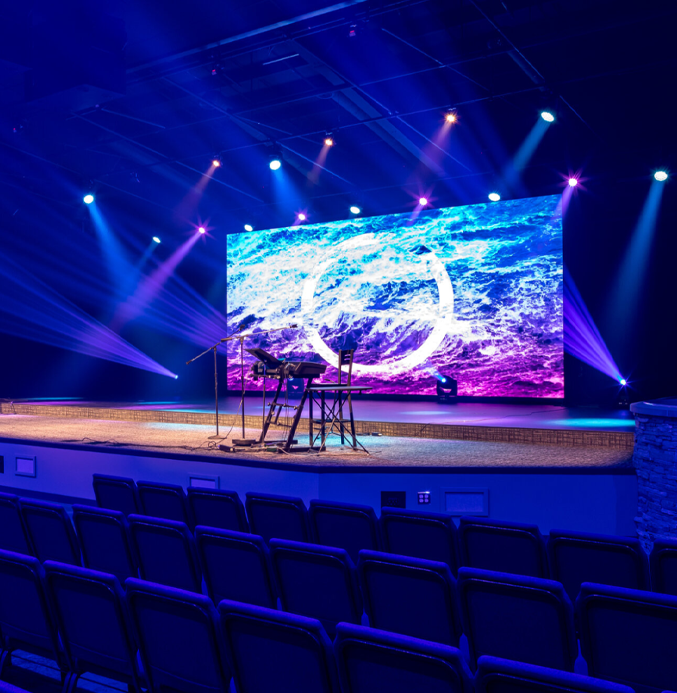
Modern church worship embraces advanced audio-visual (AV) systems to enhance engagement and inclusivity. A Church AV System transforms services with dynamic audio, immersive visuals, and integrated lighting, fostering spiritual and community connections. This guide explores its key components, selection criteria, costs, installation, and maintenance for a seamless worship experience.
What Is a Church AV System?
A Church AV System is a combination of audio, video and intelligent lighting to improve worship. It helps create effective and efficient collaboration of audio and visual elements to make church content more accessible to everyone in the venue.
These are usually systems for sound and video for sermons and audio and video presentations of Bibles and other media, as well as lighting fixtures to create the right atmosphere. Audio components such as microphones, audio systems, and speakers amplify sermons and songs so that all attendees can listen, no matter the venue’s capacity.
There are also visual components, including projectors or LED walls, which display lyrics, scriptures, and multimedia for the viewers’ concentration. Lighting systems brighten up the church and also direct them to areas of interest such as the pulpit, the choir, or any other place with a spirituality that goes with the theme.
Modern church AV systems are integral for accessibility, offering features like closed captioning and live streaming to connect with broader audiences, including those unable to attend in person
Major Components of a Church AV System
Audio Equipment
Sound quality is crucial in worship settings. A standard setup includes microphones (lavalier for pastors, dynamic for vocalists), amplifiers, and speakers. For larger venues, line-array speakers ensure even sound distribution. Digital soundboards allow precise control over levels and effects, facilitating seamless transitions during services.
Visual Equipment
Visual technology elevates the worship experience. High-definition projectors and large screens display multimedia content such as song lyrics or scripture passages. LED walls provide vibrant displays suitable for large sanctuaries, while professional cameras enable live streaming for remote congregants. Multiple camera angles and advanced projection tools can add a dynamic touch to online broadcasts.
Lighting Systems
Lighting plays a critical role in ambiance and visibility. Programmable LED lighting creates mood-appropriate effects, while stage lighting highlights key participants. These systems also address practical needs, ensuring hymnals and scriptures are legible in varying light conditions
Control Systems
Integrated control systems simplify managing AV setups. They enable technicians to adjust sound, visuals, and lighting through user-friendly interfaces, ensuring smooth services. Advanced systems can automate processes, reducing the likelihood of technical hiccups.
How to Choose Your Church AV System
Key Considerations
- Church Size and Layout: Larger spaces require sophisticated systems like line-array speakers and LED walls, while smaller spaces may suffice with basic projectors and speakers.
- Audience Needs: What accessibility features do you prioritize? It could be captioning, assistive listening devices, etc. The goal is to ensure inclusivity for all congregants.
- Budget and Funding: Determine a feasible budget. Prioritize quality over optional features to maximize value
Steps to Evaluate Existing Infrastructure
- Assess current AV systems to identify gaps in audio clarity, visual quality, or operational ease.
- Engage professionals for a site assessment to recommend appropriate upgrades.
Practical Tips
- Future-proof your investment by choosing scalable systems that accommodate growth.
- Opt for modular setups to allow easy integration of new technology.
Church AV System Installation Process
Installing a Church AV System involves multiple steps to ensure optimal performance:
- Planning: Collaborate with AV professionals to design a system that meets the church’s unique needs. This includes mapping out speaker placements and screen positions.
- Infrastructure Preparation: Install cables, mounts, and power supplies before setting up equipment.
- Equipment Setup: Position speakers, projectors, and cameras for maximum impact. Ensure lighting fixtures are adequately angled for uniform coverage.
- System Integration: Calibrate audio and visual settings to ensure compatibility and smooth operation. Use integrated control systems for ease of use.
Common Pitfalls to Avoid
- Poor Planning: Lack of provision for expansion is avoided at all costs and results in costly upgrades which are usually inevitable in the near future.
- Improper Calibration: Something like the speakers or projectors being positioned off slightly can also lower the experience.
- Insufficient Training: Equip staff with training to handle technical issues.
Maintenance and Upgrades for Church AV Systems
Routine Maintenance Tips
Regular upkeep ensures the longevity and optimal performance of a church AV system. Essential maintenance steps include:
- Cleaning Equipment: Dust buildup on speakers, cameras, and projectors can compromise performance. Use soft, lint-free cloths to clean sensitive components like lenses and LED screens.
- Cable Management: Inspect and organize cables to prevent tangling, fraying, or signal interruptions. Use cable organizers for safety and efficiency.
- System Updates: Keep firmware and control software updated to access new features and security patches.
- Regular Testing: Periodically test all components before services to detect and address issues proactively.
When to Upgrade
Signs that your system may need an upgrade include:
- Performance Decline: Frequent disruptions or outdated features indicate it’s time for enhancements.
- Congregation Growth: Upgrading to larger screens or more powerful audio systems can better serve the audience as attendance increases.
- New Technologies: Incorporating live streaming, wireless microphones, or enhanced lighting systems can improve both in-person and remote worship experiences.
Integration of New Technologies
Adding new features, such as cloud-based control systems, can future-proof your AV setup. Modern solutions like 4K projectors and automated lighting systems ensure your church remains technologically relevant. Professional consultation is key to seamless integration.
Conclusion
From basic setups to sophisticated integrations, an audiovisual system can adapt to any congregation’s needs. With proper planning, installation, and maintenance, it ensures worshipers hear every syllable and follow along with vibrant displays. It also enhances communication, fosters engagement, and future-proofs the church experience for evolving technological landscapes.

Enter the digital world with our advanced display technologies.


